Horses are herbivores with a unique digestive system, therefore they have specific dietary needs. Horses actually spend most of their time eating little and often throughout daylight hours.
Horses require a high-fibre plant based diet, consumed by intermittent grazing on pasture and hay throughout the day. Grasses, legumes, hay and roughage make up a high percentage of their daily intake and the occasional treat in the form of fruits and vegetables can boost their nutrition and hydration levels.
We often see horses out to pasture, munching on what may seem like healthy grasses but there are all sorts of greenery that can enhance the health of our equine or hinder it. So, what is it that we should be feeding our horses?
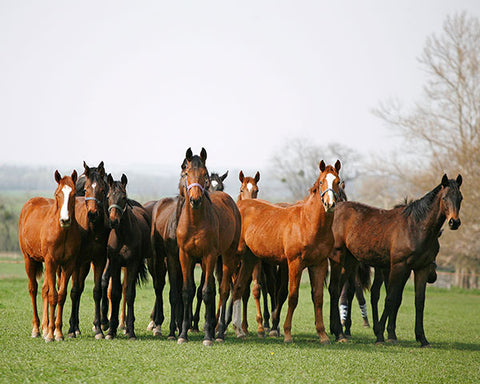
What should horses eat?
The most natural diet of a horse is pasture grass and tender plants and the bulk of their diet should consist of this. Frequent or constant access to hay or grasses helps to keep your horse's digestive system working effectively.
The best types of food for horses are:
- Grass - Good quality pastures contain the majority of nutrients that horses require to have a well rounded diet. Grass also contains silica which is important for their dental health.
- Hay or haylage - a good alternative to the grassy pastures during the cooler months from autumn until early spring to provide much needed nutrients.
- Fruit and vegetables - Horses can eat a variety of fruits and vegetables. As well as being tasty, they provide additional nutrients, moisture and hydration to their diet.
- Concentrates - your vet may recommend concentrates if your horse is in need of extra nutrients in their diet. This could be if they are old, young, nursing, pregnant or competing. Follow the vet guidelines to ensure you provide the correct amount of concentrates in the diet of your horse. If not administered correctly, they can cause mineral imbalances.
- Salt - Horses love a salt supplement especially during the summer months. You can provide a salt lick block or loose salt in a separate container.
Water is essential to all animals. Make sure your horse has access to fresh water as much as possible. Lack of water after a feed can cause blockages in the digestive system from food moving too quickly. Ensure your horse has enough water especially after feeding and take precautionary measures so that it doesn’t freeze over in the winter.
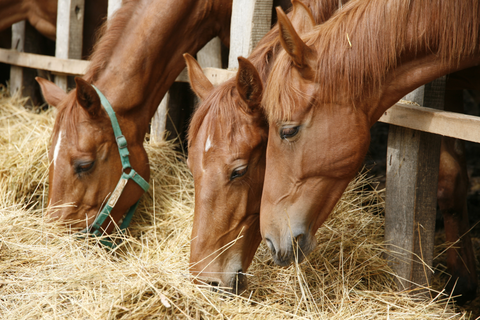
What is the best food to feed a horse?
Most horses will meet most of their nutritional needs through grazing of nutrient rich pastures or hay. Although quality grazing pasture is a lot better for your horse's diet than eating hay in confinement, grass pastures alone often don’t meet the greater energy and nutrient needs of horses.
Legumes such as lucerne and white clover can be added to your grassy pastures to meet the additional nutritional needs of your herd. Both these legumes contain more digestible energy and crude protein than grasses alone and provide a great option if you want to limit the need for adding grains to their diet.
Grass legume pastures not only provide more nutrients to your horses, they also:
- Increase crop yield
- Control weeds that may grow
- Improve seasonal distribution of forage
- Adapt better to weather conditions
- Fix nitrogen from the air and hold it in the soil
Legumes such as lucerne and clover are commonly used in horse hay but are rarely used as the sole forage species in grazing. They are best mixed with grass for a few reasons:
- Lucerne and clover can make horses “hot” due to the high protein content, this can impair the horses ability to dissipate heat in warm weather or cause dehydration.
- This extra protein cannot be stored in the body in the same way as fat or carbohydrates and must be excreted.
- They may compensate for this by drinking more water causing high urination and increased ammonia odour.
- Ammonia in stalls can irritate the airways and cause respiratory problems.
- It is also nutrient heavy and may provide more nutrients that non working horses need.
- Your horse may gain unwanted weight or cause obesity without adequate exercise.
- Clover doesn’t regrow well by itself when grazed by horses, mixing with grass encourages regrowth.
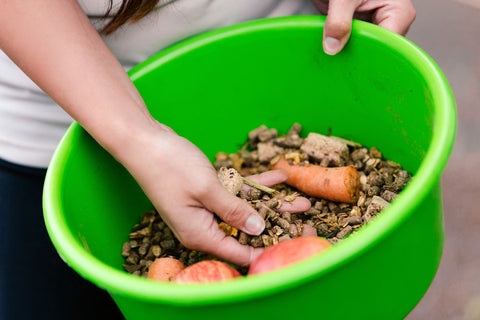
What is the best grain to feed a horse?
Pleasure or trail horses don’t need grain to be healthy, good quality hay or pasture is sufficient. If you find hay isn’t enough for your horse's daily food intake, then grains can be added for extra nutrition. Keep in mind though, the bulk of a horse's calories should come from roughage.
If you are looking to mix up your horse's diet, the most common grains fed to horses are oats, barley and corn. This is due to the fact that they are high in energy and lower in fibre than most roughages.
Oats
Oats are the most popular and safest grain to feed horses. It is the safest due to the fibre content which is 13 percent. As oats have more bulk per nutrient content, your horse has to eat more to satisfy their nutrient requirements. That makes it harder for your horse to overeat, reducing their risk of colic or founder.
Oats can be eaten by your horse either whole or processed. While whole oats are digested relatively easily, less chewing is required when the kernel coat is broken from processing. This means the digestive juices have better access to the kernel when the oat is processed, making digestion easier.
Barley
Although barley is very similar to oats as a feed it is lower in fibre and classed as a ‘heavy’ feed. As well as this, the barley kernel is harder to digest than the oat kernel so rolling is preferred before feeding. When it is crushed or ground, the heavy kernels can cause colic unless it is mixed with a bulkier feed such as wheat bran.
Corn
Corn contains a high content of carbohydrate and is one of the most energy dense feeds for horses. An equal volume of corn will have three times the amount of energy to that of oats. If corn is fed to your horses in the correct quantity or mixed with other grains it can be an excellent source of staple food.
Corn can be fed to your horses in the following ways:
- On the cob - great for horses that eat too fast but not good for older horses or those who have difficulty chewing. Costly to store but lasts longer than shelled corn.
- Shelled whole corn - processed corn increases digestion of the kernels.
- Cracked corn - allows digestive juices to penetrate and increase digestion.
- Steamed rolled corn - steam rolling further processes the kernel and creates a larger surface area for increased digestion.
Ground or crushed corn can be too small for horses to digest effectively as it can pass too quickly through the small intestine and lead to fermentation in the hind gut. This can unfortunately lead to colic.

What is colic in horses?
Horses are prone to “colic” and it is a common concern for horse owners. It is a term to describe a painful abdomen. In horses, this is usually caused by problems in the gastrointestinal tract as they have unique digestive systems and microflora.
Symptoms of colic in horses include:
- Looking at their side frequently
- Biting or kicking their flank or belly
- Lying down or rolling
- Lack of faecal matter
- Faecal matter smaller than normal
- Dry or mucus covered manure
- Not eating as much
- Change in drinking and eating behaviour
- Heart rate over 45-50 beats per minute
- Tacky gums
- Off coloured mucous membranes
Reasons that colic can occur in horses:
- High grain diets or low forage diets
- Mouldy or tainted feed
- A sudden change in feed
- Parasite infestation
- Lack of water consumption
- Stress
- Dental issues
- Long term use of NSAIDS
Getting to know signs of colic and how to avoid or treat them is crucial to keeping your horse healthy. A healthy diet and access to fresh water will help you to prevent colic in your horses.
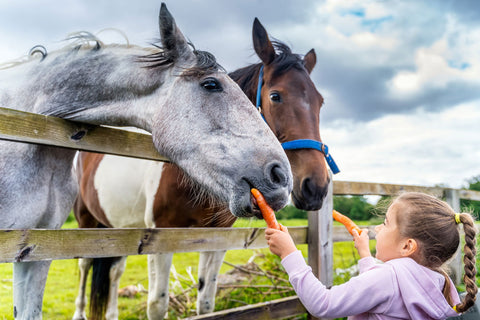
What fruits and vegetables can you feed your horse?
Horses love to snack on fruits and vegetables. Like most treats, they are only good for your horse in moderation. So keep them as an occasional luxury. They can be good to use during training, rewards and showering your horse with a little extra affection.
- Apples and pears - Horses sure do love their apples and pears as a sweet and hydrating treat.
- Peaches and apricots - Sweet and delicious but make sure to remove the pits first.
- Bananas - Horses can eat the whole banana, peel and all. However make sure the stem is completely removed.
- Beetroot - Beetroot pulp is a common feed product for horses and they can eat beetroot too.
- Berries - They may find bushes of berries in the wild, it is completely safe as long as they’re not eating too many.
- Carrots - A favourite go to treat for many horses and their owners.
- Celery - A hydrating option for your horse to snack on - they can eat the leaves too.
- Cherries - Make sure to remove the pits so your horses don’t choke on them.
- Cucumber - A refreshing snack for your horse, too much can cause gas so keep it minimal.
- Green beans - Your horse will love some green beans in moderation.
- Citrus fruits - Your horse can eat most citrus fruits such as oranges and limes as long as the peel is removed first.
- Watermelon - A great way to hydrate your horse, they can eat both the flesh and the rind.
Remember that horses can consume some fruit and vegetable skins if they’re not too thick. But it’s important to remove any rind, seeds or pits from fruit before feeding them to your horses as they could be a choking hazard.
Fruits and vegetables can be fed to your horses fresh or dried, dried can be a better option for storage purposes. Your horses should only consume fruits and vegetables as treats as their main diet should consist of grasses and hay.
How often should horses eat?
Unlike us humans, horses graze on their feed most of the day and don’t require specific mealtimes. However, horses do like a routine, and will appreciate being fed at the same times every day. If possible, you should feed your horse little and often throughout the day.
If you keep your horse in a stable you will need to top up the feed at least two to three times a day. Remember, your horse should not be left for longer than eight hours without food. It's also important to make sure their troughs are clean. If they aren’t you may find your horses refuse to eat from them.
What should horses not eat?
It might be tempting to experiment with what your horses will like to eat. Of course, we want you to discover their favourite treats for those times you want to spoil them. But remember, equine digestive systems are specifically designed to process plant based food only, so avoid meat products at all costs.
Poisonous plants for horses
If your horses are grazing on pasture, poisonous plants can definitely be a concern. Most pastures are likely to have some degree of toxic weeds or unwanted plants growing on it. Fortunately, most of these toxic plants are bitter to taste and your horses will avoid them if they can.
As horses are generally large animals, they would need to consume large quantities of any kind of plant for it to have a major effect on them. Although poisoning from plants is not a common occurrence, it’s important to be able to recognise toxic plants and understand the symptoms your horse may present if these toxicities occur.
These are just some of the plants that can cause harm to your horses in New Zealand:
Bracken fern - This perennial fern with triangular leaves can reach two or three feet high. Commonly found in open forest and temperate areas it contains thiaminase which inhibits the absorption of vitamin B1. Deficiencies in this vitamin B1 can cause neurological impairment. If your horse develops a taste for this fern, you can usually reverse the effects with high doses of vitamin B1 over the course of a couple of weeks.
Hemlock - This multi-stemmed weed has toothed fern like leaves and clusters of small white flowers. It is most common in coastal and sub coastal areas. Hemlock contains several neurotoxins that affect the central and peripheral nervous system. It is usually avoided by animals, however it’s integral to keep an eye out for this plant as there is currently no treatment if your horse were to consume large amounts of it.
Johnson grass - This is a coarse stemmed grass with broad veined leaves that can reach up to two metres high. It is common in coastal and sub coastal areas. Johnson grass is known to contain a cyanide compound which can inhibit the horses ability to absorb oxygen. The adult plant is less harmful but consumption of young or trampled leaves can lead to suffocation in horses.
Oleander - a common house plant has elongated, thick leathery leaves that can grow to 10 inches. The pink or red flowers grow in clusters at the end of the branches. Up to 30 or 40 leaves of the Oleander plant can be deadly in horses. If treated early, with antiarrhythmic drugs the heart can be stabilised.
Yellow starthistle - This weed can grow up to a metre tall and develops a spherical plant with yellow flowers and stiff spines. It contains a toxic agent that can cause neurological damage to the brain. If your horse consumes between 50 and 200% of their own body weight over a three month period this plant can cause permanent damage to your horse.
Fruits and vegetables
There are even some foods classed under fruits and vegetables that you will want to avoid giving your horses altogether:
- Rhubarb - Although the stems are edible, the leaves contain potent toxins that can be lethal if ingested by horses. They irritate the digestive system which can cause kidney damage and even death. It’s best to stay away from it entirely.
- Caffeine - any foods or drinks with caffeine can cause irregular heart rhythm in your horse.
- Chocolate - as with cats and dogs, the theobromine in chocolate can cause severe colic, seizures, metabolic derangements and internal bleeding in horses.
- Garlic and onions - members of the allium family which includes leeks, chives, scallions and shallots contain N-propyl, a chemical that can destroy red blood cells and cause anaemia.
- Tomatoes, chilli peppers and eggplants - The leaves of tomatoes can cause colic by slowing gut function. Plants classed under the Solanaceae family contain hyoscyamine which decreases saliva production and intestinal motility, it also can increase the heart rate and cause constipation or diarrhoea.
- Fruit seeds and pits - besides pits and seeds being a choking hazard for horses, some fruit seeds contain cyanide, such as apples, peaches, nectarines and apricots. Cyanide can be toxic if ingested in large quantities.
- Potatoes - If potatoes are rotten or green they may contain chemicals that can cause toxicosis in animals.
- Avocado - Although the flesh of the avocado is not toxic to horses, the skin, pit and leaves of the plant are. To be sure, don’t let your horse near avocados or their trees.
- Cake - If you want to make your horse a birthday cake, consider using ingredients that your horse will love and can easily digest such as oatmeal and some veggies. Cake as we know it is not a healthy option for our equine.
- Bread - baked goods are of little nutritional value to horses and can create a stodgy mess in their intestines. This can lead to blockages and colic so should be avoided.
- Dairy products - Horses are unable to digest lactose and may cause illness in your equine. Avoid dairy, such as yoghurt, cheese or any other milk products.
If you think your horse has consumed something toxic and is presenting any kind of symptoms, consult with your vet as soon as possible for a treatment plan.
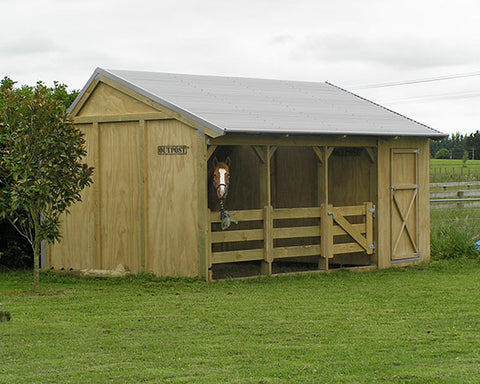
Can a horse eat too much?
Although your horse should have regular or constant access to quality pasture or hay, it is possible for them to eat too much! Too much delicious hay or foliage can cause obesity which can lead to further health complications such as equine metabolic syndrome or laminitis.
Overfeeding is particularly a problem in young horses. You may be tempted to keep your foal looking plump, however growing too fast can cause joint malformations. A holding stall or temporary fencing can be used to help control overfeeding.
Underfeeding can also be a problem, especially for senior horses or working horses. If your hay or pastures are not enough to keep your equine in their best health, you might want to consult with your vet about adding concentrates or supplements to your horse's diet to make up the shortfall of nutrients.
Remember that underfeeding hay or pasture and overfeeding of grains and concentrates can lead to colic. The bulk of your horse's diet should be made up of grass or hay.
Provide the best shelter, utmost comfort and ultimate protection for your horses with Outpost Buildings horse stables. Our horse stalls, paddock shelters and stables are strong and designed with the comfort and safety of you and your horses in mind. Contact us today for more information.





